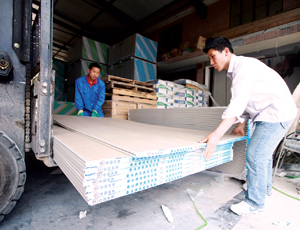Several U.S. senators are pushing federal agencies to step up their response to reported health problems in houses with drywall imported from China. Lawmakers have in hand a U.S. Environmental Protection Agency analysis showing that unlike the U.S.-made product, Chinese-made drywall contains sulfur and two other organic compounds that occur in acrylic paint. EPA’s study, released on May 19, also says Chinese drywall samples had 10 times the level of strontium found in U.S. wallboard.

The lawmakers used a May 21 hearing of the Senate consumer protection, product safety and insurance subcommittee to press officials from the Consumer Products Safety Commission (CPSC) and EPA to move as rapidly as possible on deeper and broader follow-up drywall tests. They also are seeking ways to provide funds for those studies.
So far, CPSC has heard from 320 people in 16 states and the District of Columbia who reported health problems or metal corrosion in their houses they attribute to Chinese drywall, says Lori Saltzman, director of CPSC’s division of health sciences. Saltzman told the panel CPSC is evaluating the relationship between imported drywall and health symptoms, such as coughing, headaches and nosebleeds, as well as links to corrosion of home fixtures and wiring. CPSC also is attempting to trace where the drywall originated and how it was distributed.
Elizabeth Southerland, acting deputy director of EPA’s Superfund remediation and technical innovation office, said a federal-state team is developing indoor-air sampling protocols for characterizing gaseous emissions that may be causing problems. The first phase may include analyzing other drywall samples, identifying chemicals and gases as possible odor sources and developing analytical monitoring methods.
Phase two, field-testing draft protocols in three Florida houses and three Louisiana houses, is to begin this month. By the end of June, agencies expect to agree on a final protocol, which could lead to a broader range of home tests.
Sen. Bill Nelson (D-Fla.), a leader of the push to deal with drywall, said agencies’ response has been “way too slow,” but added, “I think that we’re all in the harness pulling in the right direction.”
Nelson and Sen. Mary Landrieu (D-La.) tried, but failed, to get $2 million for Chinese-drywall testing in a supplemental spending bill that the Senate approved on May 21. Nelson did elicit a statement from Appropriations Committee Chairman Daniel Inouye (D-Hawaii) that he would put “the full impact of his office” at Nelson’s disposal to get CPSC and EPA to carry out the further drywall tests. Saltzman said CPSC already is shifting funds within its budget to work on the issue.
With EPA’s first test results, Nelson said, “We’ve got the what and now we need the why—and how do we fix it?” He and other senators at the hearing were sympathetic to homeowners, such as witness Richard Kampf, who said he paid $315,000 for his Cape Coral, Fla., house. Its value now is zero. “I have nosebleeds every day,” he said. But lawmakers did not have any immediate options for alternate housing or repair.
“In the end, I think all this stuff is going to have to be ripped out,” Nelson said. Randy Noel, president of Reve Inc., a Louisiana builder, told the panel it probably would cost about $100,000 to gut each house and install new drywall. He said Louisiana builders’ preliminary estimates indicate 500 homes in the state may be affected. Noel said the only funding source homebuilders see for such repairs is the federal government.
Noel, testifying for the National Association of Home Builders, said more than 60 drywall lawsuits have been filed in seven states, with most cases in Florida and Louisiana.


Post a comment to this article
Report Abusive Comment